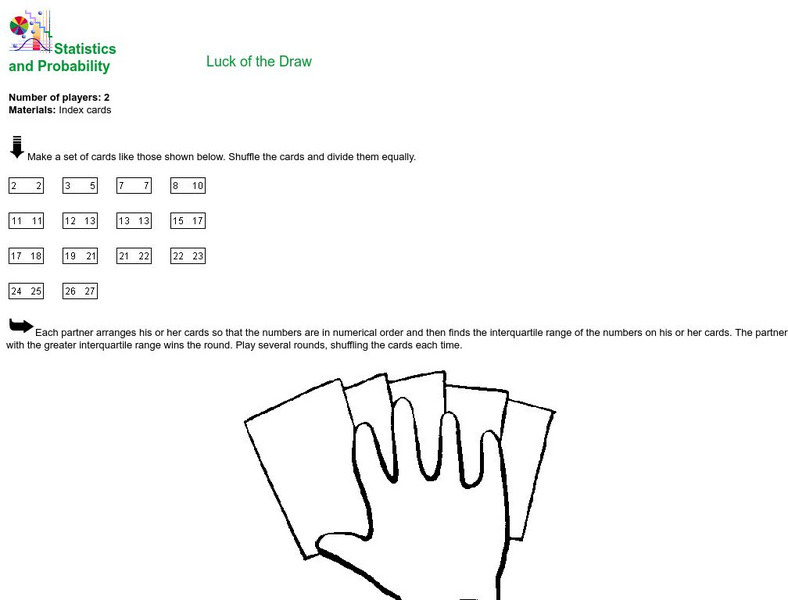Hi, what do you want to do?
Curated OER
The Quadratic Formula
Students solve quadratic function by completing the square. In this algebra activity, students use the quadratic formula to factor quadratics and find the roots. They graph the parabola and identify its properties.
Curated OER
Soaring Towers
Students build towers from recycled materials. in this building lesson, students build the highest tower they can from varied materials. They focus on shapes and which items should go on the bottom to make a strong base.
Curated OER
Duplicating Segments and Angles
Tenth graders investigate geometric construction. In this geometry lesson plan, 10th graders explore the procedure for copying an angle and a segment. The lesson plan emphasizes the difference between a sketch, a drawing, and...
Curated OER
Paper Planes
In this unit, 3rd graders investigate one variable to see if they can make a paper plane fly farther. They use scatter plots to establish a possible relationship between variables then use what they have found to make a paper plane to...
Curated OER
School Yard Park/ Ecosystem
Fifth graders examine ecosystems in their schoolyard. In this nature and ecosystem lesson, 5th graders map their schoolyard into workable plots. They classify plants and animals found in the plot. They revisit their site every two weeks...
Curated OER
Using Computer for Statistical Analysis
Students examine the use for spreadsheets in analyzing data. They make spreadsheets that display and calculate a given data set such as temperature change.
Western Kentucky University
Understanding Genetics: Punnett Squares
Can scientists really predict genetic outcomes or are they simply making a lucky guess? Scholars first learn about Gregor Mendel and how to make Punnett squares. Then they extract DNA from a strawberry in a lab with included conclusion...
Curated OER
Growing Plants
Students grow plants and track their growth over time. In this growing plants lesson, students plant seedlings and chart their growth in a data analysis activity.
Curated OER
So Sweet
Learners compare sugar levels in cereals. In this nutrition lesson, students learn how to read a nutrition facts label, predict which products will have the most sugar, discover which cereals contain the most sugar and discuss...
Curated OER
Autumn Bulb Planting Outside - Making a Daffodil Spiral
Learners plant daffodil bulbs. In this gardening activity, students work outside to plant daffodil bulbs in the autumn so that they can grow roots and emerge by spring.
Curated OER
Read the Label
Students read the Nutrition Fact labels to make healthy choices. For this health lesson, students look at labels to identify fat content, protein, carbohydrates, and serving size. They play games with different labels such as Narrow It...
McGraw Hill
Glencoe: Self Check Quizzes 1 Median, Mode and Range
Use Glencoe's randomly generated self-checking quiz to test your knowledge of median, mode and range. Each question has a "Hint" link to help. Choose the correct answer for each problem. At the bottom of the page click the "Check It"...
McGraw Hill
Mc Graw Hill Education: Glencoe: Statistics and Probability: Luck of the Draw
Instructions for creating and playing a simple card game through which students can practice calculating the interquartile range from a set of numbers.
Wolfram Research
Wolfram Math World: Calculus and Analysis
Over two dozen links are provided at this MathWorld site. From Polynomials and Series to Dynamical Systems and Catastrophe Theory, each link provides in-depth explanations and relevant diagrams of the topics at hand.
Math Is Fun
Math Is Fun: Mathopolis: Quartiles Practice
Multiple-choice practice problems that review quartiles. Incorrect answers are corrected with short tutorials.
Oswego City School District
Regents Exam Prep Center: Error in Measurement
What are the common errors made when students take measurements and how can they be avoided? A good deal of vocabulary associated with measurement errors is explained. Tips are provided for the student and the teacher in hopes of...
Illustrative Mathematics
Illustrative Mathematics: G Mg How Thick Is a Soda Can? Variation I
In this task, students are given the dimensions of a soda can and are asked to estimate its thickness. They must first find the surface area and the volume of aluminum. Aligns with G-MG.A.1 and G-MG.A.2.
Soft Schools
Soft Schools: Outliers
On this websites students explore the concept of outliers. Students are given several data sets and investigate how outliers can effect the mean and median of a data set.
Illustrative Mathematics
Illustrative Mathematics: G Mg How Thick Is a Soda Can? Variation Ii
In this task, young scholars are given an aluminum soda can and are simply asked how they could determine how thick the can is. Aligns with G-MG.A.1 and G-MG.A.2.























